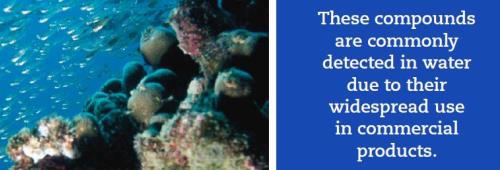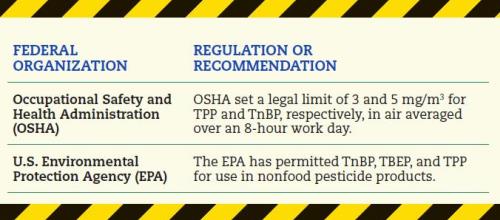
Phosphate Ester Flame Retardants
On this Page
- Phosphate Ester Flame Retardants Overview
- Phosphate Ester Flame Retardants and the Environment
- Exposure to Phosphate Ester Flame Retardants
- Phosphate Ester Flame Retardants and the Body
- Health Effects of Exposure
- Phosphate Ester Flame Retardants and Children
- Reducing Risk of Exposure
- Exposure Testing
- Governmental Recommendations
- Additional Information
Phosphate Ester Flame Retardants Overview
 Phosphate ester flame retardants are human-made chemicals added to consumer and industrial products for the purpose of reducing flammability.
Phosphate ester flame retardants are human-made chemicals added to consumer and industrial products for the purpose of reducing flammability.
Phosphate ester flame retardants are composed of a group of chemicals with similar properties but slightly different structures. Phosphate esters are typically liquids at room temperature; however, some are solids.
Phosphate esters have a multitude of uses including flame retardants, plasticizers, hydraulic fluids, solvents, extraction agents, antifoam agents, and coatings for electronic devices. Top of Page
Phosphate Ester Flame Retardants and the Environment
Phosphate ester flame retardants are released to the environment from industrial sources and disposal of consumer products containing flame retardants.
Phosphate ester flame retardants can change chemical composition in the environment. There is no specific information available for these phosphate ester flame retardants; however, in general, these compounds are degraded by chemical reactions in the air. If they attach themselves to particles, they can settle out onto the ground. Generally, most phosphate esters are poorly soluble in water and adsorb strongly to soils. These compounds are commonly detected in water due to their widespread use in commercial products. Phosphate esters are subject to biodegradation in aquatic and terrestrial environments.
Exposure to Phosphate Ester Flame Retardants
Humans can be exposed by a combination of oral, inhalation, and dermal routes.
Ingesting food contaminated with phosphate esters is the primary source of exposure. Most foods have been found to contain trace amounts of phosphate ester flame retardants due to their wide use in plastics and presence in the environment. Breathing in contaminated air, both outdoor and indoor, is a potential route of exposure. Hydraulic fluid is the primary source of phosphate esters in outdoor air. Indoor air can contain phosphate ester flame retardants from certain plastics, adhesives, foams, or electronics.
Drinking water contaminated with phosphate esters due to leaching from plastics or industrial waste water discharge is another potential exposure route. Additionally, you may be exposed if your skin comes into contact with contaminated soil. Hydraulic fluid spills or industrial waste water used for agriculture can result in the presence of phosphate esters in soil.
Young children may be at a higher risk of exposure since they are more likely to put phosphate ester flame retardant treated materials in their mouths.
Phosphate Ester Flame Retardants and the Body
Currently, we do not know much about phosphate ester flame retardants and the body.
There is virtually no information about the entrance of these substances into the body. However, tris (1,3-dichloro-2-propyl) phosphate (TDCP) had been found in human tissues and body fluids, so we know that this substance can enter the body possibly by inhaling aerosols or dusts or ingesting contaminated food or water. Adverse health effects seen in humans after exposure to tri-o-cresyl phosphate (TCP) indicate that this substance can enter the body and pass into the bloodstream. Studies found that TDCP, tris(2-chloroethyl) phosphate (TCEP), TCP, and tri-n-butyl phosphate (TnBP) can easily pass from the stomach and intestines into the blood stream after oral exposure to these chemicals. Studies on dermal exposure found that less amounts entered the body through the skin of rats and only very small amounts through the skin of pigs.

There is no information on how these chemicals leave your body, but based on studies in animals, phosphate ester flame retardants may be broken down in the body and the breakdown product may be eliminated in the urine. However, there are no studies in humans to prove that this actually happens. Neither phosphate ester flame retardants nor their breakdown products seemed to accumulate in the body based on studies in animals. Most breakdown products were eliminated in the urine in 2–3 days. Top of Page
Health Effects of Exposure
Few studies have looked at the health effects of exposure to phosphate ester flame retardants.
Almost no information is available regarding these effects in members of the general population. However, accidental ingestion of a component of TCP has caused adverse effects on the nervous system. There have been a few cases of allergic reactions to consumer products that contain triphenyl phosphate (TPP), but a study that examined several hundred people exposed to plastics and glues that contained TPP or TCP did not find any allergic reactions.
Studies of occupational exposure to phosphate ester flame retardants found that long-term exposure of workers to TDCP, TCP, or TPP was not associated with adverse health effects. No information was available regarding occupational exposure to other phosphate ester flame retardants.


Phosphate Ester Flame Retardants and Children
Children may be exposed to phosphate ester flame retardants in similar ways as adults.
There are no studies that examined the health effects in children of phosphate ester flame retardants. Furthermore, there are no studies that examined the health effects of the phosphate ester flame retardants on pregnant women or on their embryo or fetus. There is no information regarding transfer of phosphate ester flame retardants to the fetus across the placenta in pregnant women. Additionally, no studies have been conducted to determine whether phosphate ester flame retardants can be detected in human breast milk from women exposed at work or from the general population.
There have been some studies done in laboratory animals on the effects of phosphate ester flame retardants in utero. In general, exposure of rodents during gestation to TCEP, TnBP, TBEP, TDCP, TPP, or TCPP did not result in adverse effects to the fetuses or newborn animals. However, continuous exposure of two generations of mice to TCEP reduced the number of male pups born alive in the third generation. A similar study with TnBP in rats found that pups born to exposed rats had lower body weight during the first weeks of life than pups born to untreated rats. Studies in rats and mice also found that exposure to TCP before and during pregnancy can increase the number of pups born dead.
Reducing Risk of Exposure
If you believe that you have been exposed to high levels of phosphate ester flame retardants, you should contact your doctor or local health department.
In order to reduce the risk of exposure to phosphate ester flame retardants, avoid food that is generally high in phosphate ester content as indicated by the current market basket for the U.S. Total Diet study.
Additionally, avoid installation or use of materials that are known to contain phosphate ester-based flame retardants in indoor environments to minimize exposure to them via air and particulate matter.
Exposure Testing
Phosphate ester flame retardants can be measured in blood and urine.
This is not a routine test that can be performed in a doctor’s office. You should, however, see a physician if you believe that you have been exposed to high levels of these substances. No studies have been conducted to measure these chemicals in blood samples from groups of people representative of the U.S. general population.
The presence of phosphate ester flame retardants in your blood may indicate that you have been exposed to these substances and some amount entered your bloodstream. However, the presence of phosphate ester flame retardants in your blood does not necessarily indicate that adverse health effects will occur. Additional studies are needed to help to determine the health effects associated with exposure to these substances.
Governmental Recommendations
Recommendations and regulations are updated periodically as more information becomes available.
For the most current information, check with the federal agency or organization that issued the regulation or recommendation.
Some regulations and recommendations for phosphate ester flame retardants include the following:
Additional Information
If you have any more questions or concerns, please contact your community or state health or environmental quality department or contact ATSDR at the address and phone number below.
Agency for Toxic Substances and Disease Registry
Division of Toxicology and Human Health Sciences
1600 Clifton Road NE, Mailstop F-57
Atlanta, GA 30329-4027
Toll-free information and technical assistance:
1-800-CDCINFO (1-800-232-4636) Top of Page

- Page last reviewed: October 14, 2015
- Page last updated: October 14, 2015
- Content source:



 ShareCompartir
ShareCompartir






